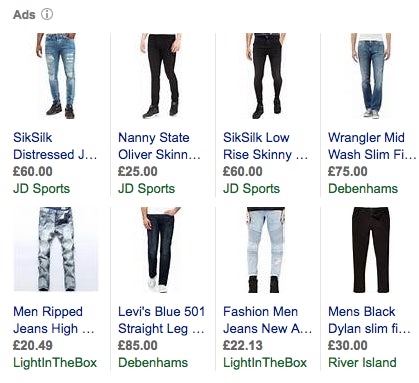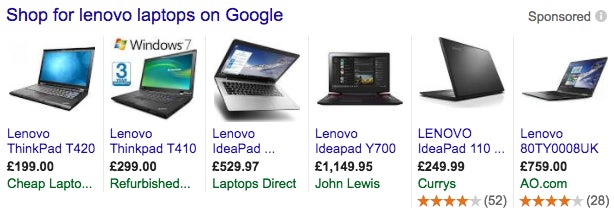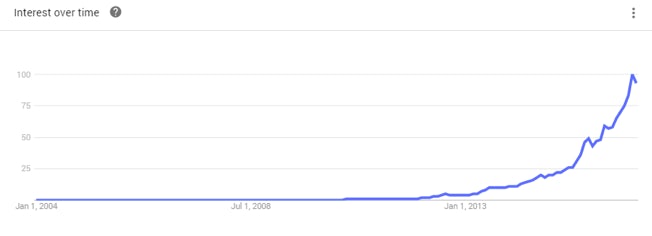At the end of 2016, Merkle discovered that Amazon was again testing with Google’s paid product listing ads (PLAs). If ecommerce giants like Amazon decide to start dominating paid results, is there anywhere left for smaller ecommerce sites to gain visibility?
How significant are the tests?
At present, the tests that Amazon have been conducting seem to short term and contained to a few regions. Their PLAs were spotted in the US towards the end of 2016, and one commenter on Merkle’s piece said that they had been seen in India for over a year at that point.
However, we have yet to see any ads in the UK, according to our observations via SEMRush, and it seems like the testing is dying down over in the US as well. So is all of this just a blip that can be safely ignored?
Possibly, but Amazon is growth-hungry and you can guarantee they will press on with PLAs if their tests were successful. It’s easy to see how the ads could benefit the ecommerce juggernaut – PLAs are perfectly poised to allow a company like Amazon to push new products and win customers for specific categories.
Despite the fact that paying for PLAs means Amazon giving more money to Google – one of their biggest competitors, it is hard to see them holding out for much longer. We would not be surprised to see more PLAs globally in the future if Amazon decides that the test was worthwhile, and with their vast understanding of products and audiences, such ads are likely to make a big impact on the market.
Possible implications for the market
A greater Amazon presence in the SERPs is good news and bad news. It’s good news for consumers looking for cheap products and reliable service – Amazon could only grow to its present size with millions of satisfied, loyal customers behind it.
Machine learning is helping Amazon to cross-sell products more effectively, and tweaks to Prime and customer accounts are steadily reducing any friction on the path to purchase. The company is continuing to shout about ‘customer obsession’, and the numbers of loyal customers are rising in their millions.
For competitors, especially smaller businesses, the news of an Amazon foray into paid SERP real estate will be much less welcome. Big retailers already take up many of the organic results in the SERPs, leaving paid ads as the only way that a lot of smaller businesses could get visibility. If that space starts to disappear, then SMEs could end up with almost nowhere left to go.
Essentially, the barrier to entry for smaller and newer businesses looking to grow market exposure would be raised, with more money needed to compete for less space in the SERPs. The ability of small businesses to win new customers through traditional channels would be reduced.
Some caveats to be aware of
Before we take a look at what SMEs can do to retain their exposure in the SERPs and elsewhere online, there are some caveats to this issue that we need to remember.
First and foremost, this discussion of the future of the SERPs is, at present, mostly speculation. It can’t be denied that Amazon has shown interest in PLAs multiple times, but that is all that we can say with certainty at this stage. However likely it may seem that Amazon will start to wade further into the paid advertising space, they are yet to do so fully, and may still abandon this trial altogether.
It is also important to remember that even if Amazon were to invest more heavily in PLAs, it’s not the case that all paid spots would just disappear. For the majority of searches, Amazon might win a few of the available spots, but there would still be a number up for grabs depending on the carousel or grid PLA format for that search query and device. Yes, competition would be fiercer, and the spots might be more expensive, but that won’t necessarily mean that they would be impossible to obtain.
As we will continue to discuss in this post, there are other ways to gain exposure on Google and in front of online audience than the big product keywords that Amazon and other larger ecommerce sites tend to target. Google is improving the results they offer for searches that don’t have a purely transactional intent, and the world of local search continues to grow. There are ways to reach audiences that bigger sites simply can’t replicate.
Opportunities for growth with alternative paid channels
Let’s say that Amazon judges its testing a success and decides to invest more heavily in PLAs. How can smaller ecommerce sites compete? Thankfully, paid channels offer more opportunities than Google Shopping PLAs alone, and there are ways to improve your performance in PLAs to maintain your ROI even as bigger sites muscle their way in.
Gaining an advantage through Bing
The first and most important thing to remember is that Google isn’t the only paid channel that can make you money. The search giant’s ever-present competitor, Bing, is currently developing their own shopping ads offering (see image below), and getting in there early could give your business a real edge over your competitors.

According to Liam Wade, Impression’s PPC account manager Bing’s shopping offering isn’t yet as advanced as Google’s. He went on to say, “In our tests, Bing struggles to match long-tail user queries to the correct product, or even any product at all.”
However, Bing shopping’s relative infancy means that there is even more of an opportunity for early movers to gain an advantage. At this stage, the big players like Amazon are completely ignoring Bing, and the chances are good that many of your smaller competitors are, too.
Bing might not have the traffic of Google, but it still has traffic, and there are people using it that you could reach long before your competitors.
The untapped potential of social advertising
The other main paid channel that you can use to gain an advantage is social media advertising. Social media channels let you put your ads in front of large audiences, with targeting that can be highly specific.
You can target people who have visited your site, people who have bought from you in the past, people who like your competitors’ pages on Facebook, people in various social demographics, and more. With social advertising, you identify your target audience, and make sure that those people see your ads.
One site that ecommerce marketers really need to be aware of is Pinterest. Social media meets online wish lists in this advertiser’s dream, with one early beneficiary of Pinterest’s ads estimating that Pinterest’s users had an average household income of $100,000 – that means it’s a site of people looking at products they want, with disposable income ready to spend.
Pinterest’s ads are no longer in their infancy, and they have just hired Randy Keller, Google’s former senior image search engineer, to help with their on-site search. We expect that this will lead to search results giving users better, more relevant results, which in turn will help them to see more relevant ads. Exploring social avenues, like Pinterest, is one of the best ways you can maintain high levels of customer acquisition despite diminishing SERP real estate.
The benefits of remarketing
Your marketing efforts should be be solely focused on acquiring new customers. Turning existing customers into loyal, repeat customers can also be incredibly valuable for your business, and Google’s PLAs aren’t necessarily that important for this.
Social ads can be very effective at reaching people who have bought from you before, encouraging them to return to your site. You could also consider email marketing (still a very effective channel) and other forms of Google advertising, like the visual display ads that appear on websites.
Customer retention is often cheaper than acquisition, but the value of turning a one-time customer into a loyal customer can be even greater than acquiring someone new who just buys one product. These techniques might not increase your exposure online in terms of wider audiences, but they can be very healthy for your ROI.
Optimising your existing ads
As mentioned above, Amazon’s presence in PLAs does not mean that PLAs are entirely off-limits for smaller businesses. By working on your existing ads, you could maintain your position in Google’s paid slots, even if there aren’t as many available.
Data feed optimisation
One of the best things you can do for your Google Shopping campaigns is regularly optimise your product feed. In the worst case scenario, Google will pull the plug on your ads if the information isn’t correct, and in a lot of cases, making small tweaks can give you the edge over the competition.
In particular, prioritise optimising the ‘title’ attribute, as this has been found to have the biggest impact on the volume of impressions and the search queries you’re eligible to show for. Tweak your wording and imagery to appeal to your customers; consider what search queries will they be using to find your product.
We’d also recommend adding custom attributes where possible, in order to more easily manage your bids within the AdWords interface.
Winning your branded searches
As we’ll look at more in the organic section, Google favours businesses that spend time building strong brands. For paid ads, this means that the opportunity is there for you to dominate your own branded searches, something that is particularly important as you grow. This is also a very cost effective exercises, as you’ll always pay only a small fee to appear for your own brand term – a luxury your competitors won’t see.
It is important to be aware of what your main branded searches are so that you can ensure that your data feed is optimised for them. Incorporate branded terms into your keyword research, and include those terms in product titles where it is relevant to do so. This way you will show Google that you are clearly the most relevant for those terms, and your competitors won’t be able to get a look in.
Reviews are essential
Reviews are important for both paid and organic channels, so it’s always a good idea to actively pursue good customer feedback. The big ecommerce sites have it easier when it comes to the reviews that you would see in the organic results. They are active in asking for feedback, and they have a big customer base to get reviews from.
For smaller sites, getting a good number of reviews can be harder, but there’s no reason you can’t get them if you start as soon as you can and you’re committed to pursuing them. Once you start getting reviews in, you need to make sure that they’re properly marked up so that Google can recognise and make use of them.
However, the state of play is different for the product reviews that you see in PLAs. In the image below, the two laptops displaying review stars do so because those products have gathered sufficient reviews through trusted third party review sites (like Trustpilot); it has nothing to do with the reviews for the retailer. The Lenovo 80TY0008UK product would display a 4 star review whether it was being advertised by AO.com or Laptops Direct.

This means that for branded products, all retailers are on equal ground. Smaller ecommerce retailers may find themselves at a disadvantage when they’re selling their own products and trying to compete with branded products. The branded products are much more likely to have been reviewed, and will look more attractive to shoppers. The best way for smaller companies to reduce this disadvantage is for them to continually encourage customers to review their products, so that they build up enough third party reviews for Google to recognise their ratings.
While it can be hard to get started with reviews, they sustain themselves once you get going. More reviews mean that Google will look on your PLAs more favourably, which will lead to more visibility. More visibility will then equal more sales, which will lead back to more reviews, and so the cycle continues.
Opportunities for growth with organic channels
A large part of the problem with bigger companies taking over the PLAs is they have already been dominating organic results for larger queries for a long time. There just isn’t that much space for smaller companies on the best keywords.
None of that is to say that there aren’t opportunities for organic exposure. There are still organic spots up for grabs, even for the biggest keywords, and there are other ways to gain organic exposure that the bigger companies often don’t exploit.
Start with realistic competitor analysis
If you are a newer business in your sector, then it is essential to understand what your competitors are doing. This doesn’t mean the ecommerce giants like Amazon, Tesco and Argos that compete with most small businesses across the board – if you spend all of your effort on emulating those companies, you’ll be disappointed.
Instead, focus on the companies that are closer to you in the size. These are the ones who don’t have large and varied backlink profiles, the ones who aren’t necessarily household names. This is how we started with GreatBeanBags, a dedicated bean bag retailer who now rank on page one for ‘bean bags’, and who currently (February 2017) rank above the likes of Amazon, Tesco and John Lewis.
Understanding what your competitors are doing is critical if you want to learn how to rank for your biggest keywords. If you’re a new business, many of these companies will have been working on SEO for many years, and you can reverse engineer their sites to learn how they got to their current positions.
Once you’ve done this, you know what it will take to make a site that is faster, more user friendly, and better optimised than theirs. You will also know the kinds of sites that it is worth getting backlinks from, and you know where the gaps are that will allow you to be featured in places that your competitors haven’t reached.
Google rewards topic authority
Google’s mission statement is to ‘organize the world’s information and make it universally accessible and useful’, which, for organic results, translates into showing searchers the best results for their queries. As a result, establishing a strong brand and good topic authority can get you a long way in the organic results, something that we believe has played a big part in the current position of many of our clients.
If your business specialises in one area, you can use that to your advantage. Optimise your category pages so that it’s clear that they are relevant to your specialism, and populate your site with content that shows your expertise on the subject. We’ll talk more below about informational content, but even putting a couple of hundred well-written words on each page telling users what that page is about will give you a big boost in the rankings.
Use your natural flexibility
As SEO expert Rand Fishkin discussed in one of his videos, smaller companies are better suited to thinking creatively and pursuing different angles than bigger companies whose employees have to go through multiple levels of management before trying anything new.
As a result, bigger ecommerce companies tend to focus on the big, obvious keywords that line up directly with their main product categories. Smaller companies, on the other hand, can target longer and more specific search queries that still have search volume, but have much less competition, usually specific to individual products.
For example, SEO tool Ahrefs estimates that ranking for the term ‘laptop’ is pretty difficult , but the term ‘how to choose a laptop’ is significantly easier to rank for as it’s more specific. ‘How to choose a laptop’ still has some big sites in the search results, but you’re no longer competing with thousands of ecommerce sites to rank, and you’re looking to rank for a term that should have a high click through rate, gaining you good traffic and brand awareness.
Building a strong blog is a great way to give your site some extra visibility. You can blog about everything from industry news to product comparisons, and make it possible to rank for a whole host of terms that the likes of Amazon aren’t anywhere near.
Another advantage of targeting informational searches rather than transactional searches is that you’re likely to reach searchers who are further up the sales funnel. These searchers may not be ready to buy right away, but your brand will be in their recent memory when they come to make a purchase, and such awareness works well alongside the various paid campaigns you might be running.
Use local SEO to your advantage
Local search continues to grow, as shown by the explosion of ‘near me’ searches since 2011, which you can see in Liberty Marketing’s graph below.
There is a big opportunity for smaller companies without brick and mortar stores and companies that serve a specific area to gain exposure in an environment free of global giants like Amazon.
Yes, you would still be competing against high street stores, but there is also more real estate available, with the local maps listings available to obtain organically. We’re also seeing more paid listings creeping into the local pack, but there could be an opportunity there if you value local search highly enough to try and beat your competitors to those spots.
There’s no magic formula for good local performance, but links from local sites, NAP consistency across various directories, a Google My Business account, and clear information on your site all help. If you want to find out more about local SEO, we’ve written about it more extensively before.
It’s important to remember that many local searches lead directly to customers visiting you in-store. This is the perfect opportunity to wow them with your service, and turn them into loyal customers who will continue to come back. Smaller, local businesses have the ability to get to know their customers in a way that national organisations can’t, and you should use this to your advantage.
Make use of all the channels at your disposal
The majority of the suggestions we’ve made in this post will help your business to grow and gain exposure regardless of what Amazon does, but if the ecommerce giant decides to invest more in PLAs, hopefully these tips will leave your business better placed to thrive regardless.
The good news is that there are a wide range of digital marketing tools and services available that will help smaller ecommerce businesses compete with larger companies. These tools are constantly improving and evolving, which means that staying up to date with what’s currently out there can give you a big advantage. Digital looks set to continue providing a bigger return for many businesses than the high street, so you’ll see the benefits if you keep thinking creatively and working hard.
This blog post could not have been written without a lot of input from Aaron Dicks, Impression’s managing director, and members of both our PPC and SEO teams. If you want to read more of what they have to say, take a look through some of the recent posts in our blog.




